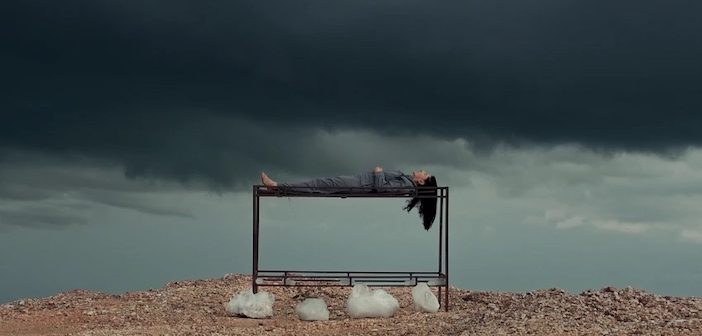Marina Abramović (Hon RA), the Belgrade-born artist, sculptor and film-maker has made performance art her life’s work. Her body has been her tool, used to create art forms that stretch the exploration of the subconscious through physical, and at times brutal, presentations. It has always been her subject and medium.
At the Royal Academy of Arts in London, the exhibition ‘Marina Abramović’ surveys her remarkable career. In the show, some of her original performances dating from 1970s are recreated as live performance by a trained team from the Maria Abramović Institute, a foundation the artist created in 2010. Her artworks, sculptures and filmed performance fill the gallery spaces, giving an insight to works that have defined her career.
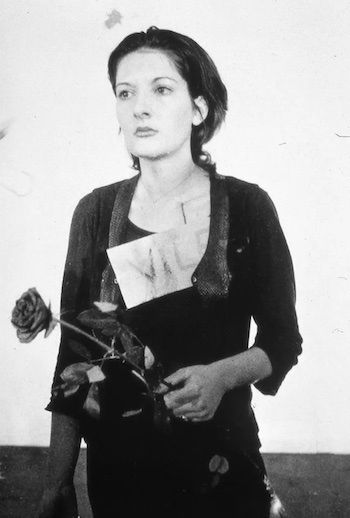
Rhythm 0, 1974.
Performance; 6 hours. Studio Morra, Naples. Courtesy of the Marina Abramović Archives, photo by Donatelli Sbarra.
Growing up in Belgrade, her life story tells of a strictly-disciplined, often cruel childhood living with her mother. Her father left the family home when Abramović was seventeen. Graduating from the city’s Academy of Fine Arts in 1970, she continued post-graduate study at the Academy of Fine Arts in Zagreb, after which a major move in her professional life was to leave home and travel. Performances of Rhythm 10 at the Edinburgh Festival in 1973, with fellow Yugoslavian artists, confirmed live performance as her art form. She said it was “the moment that I knew I had found my medium”.
At the festival she met the German performance artist Joseph Beuys, who would become a key influence on her work. Other performances from this early period on show at the RA is ‘Rhythm 0’, part of a series of five themed works created in 1974, beginning in Studio Morra in Naples. It featured a disturbing performance, lasting 6 hours, with Abramović as an object, in which there were 72 other objects on a long table that the audience could use on her as desired, including large knives, metal chains, various liquids, bread, fruit, clothing, and a gun. She took sole responsibility for audience actions. The experience was traumatising, and clearly evident in the large-scale photographic images.
In the final rhythm piece, ‘Rhythm 5’, performed in Belgrade, Abramović was a living artwork, in the centre of a 5-point star made of wooden shavings set alight with 100 litres of petrol. At this performance she lost consciousness and had to be rescued. In all, this cycle of five ‘Rhythms’ concluded her research on the body in an exploration of the conscious and unconscious.
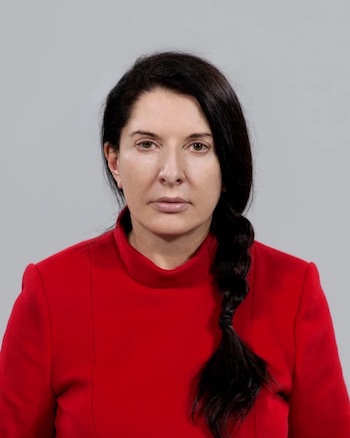
‘The Artist is Present’, 2010. Performance; 3 months. The Museum of Modern Art, New York. Courtesy of the Marina Abramović Archives. Photo by Marco Anelli
The RA show opens with a more tranquil setting, displaying public participation at a live performance that took place over 75 days, 716 hours, 75 minutes at the Museum of Modern Art, in New York in 2010. For ‘The Artist is Present’, audience individuals were invited to sit in silence, face-to-face with Abramović, for as long as they wanted. The total number participating reached 1,445. Many had queued for hours for the opportunity to take part.
It was for many individuals a deeply moving experience, the silence giving time for inner reflection. For Abramović it was a near overwhelming performance, staged each day over three months, as evident from the facial reactions, displayed on the walls for the RA show, both from these participants and Abramović herself.
A poignant presentation on show is ‘The Hero’, from 2001, a black and white video, a little over 14 minutes long, in tribute to Abramović’s father, Vojin. On display in a vitrine are his personal possessions; many military medals, and letters, amongst small mementos that belonged to him.
Another person not present who played an important part in Abramović’s personal life was the German performance artist Frank Ulwe Layssiepen, known professionally as Ulay. He collaborated with Abramović on many performances, exploring extreme states of consciousness. They had met in 1975, on their shared birthday on 30th November, eventually living together. Many of the live performances, recorded and shown in the RA show, feature their collaborative works. The now-legendary ‘Imponderabilia’ (1977), is reperformed live by members of Abramović’s MIA team. Perhaps the hardest was a collaborative performance on the Great Wall of China, to create ‘The Lovers, The Great Wall Walk’, in 1988, in which Abramović walked from the east end of the wall, and Ulay from the west. After 90 days of walking the two met. It was meant to culminate in their marriage but by the time permission was granted their lives were separate. A gallery is dedicated to their shared experience.
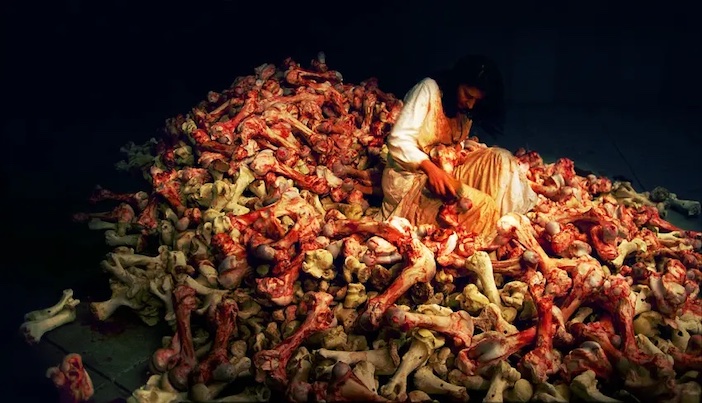
Balkan Baroque, 1997. XLVII Venice Biennale, June 1997. Courtesy of the Marina Abramović Archives
In another gallery, ‘Balkan Baroque’ is recreated. This was performed at the Venice XLVII Biennale in 1997, in a basement room with Abramović sitting, bloodied, on a massive pile of raw cow bones, symbolising the ongoing war in the Balkans in the 1990s. The performance, in the Italian pavilion in the Giardini, lasted 4 days and 6 hours – and caused a sensation. Abramović said that the smell from the rotting bones pervaded the whole building. She was awarded the Golden Lion for her performance.
This outstanding show at the RA is not the only place to be immersed in Abramović’s performance art in London. Her opera project, 7 Deaths of Maria Callas (reviewed in these pages here), with music by Mark Nikodijević, received its UK premiere at the London Coliseum, running from 3-11 November 2023. In it Abramović, and her co-performer, the American actor Willem Dafoe will ‘die’ seven times in seven films. A tribute to Callas, the opera marks 100 years since the birth of the Greek soprano.
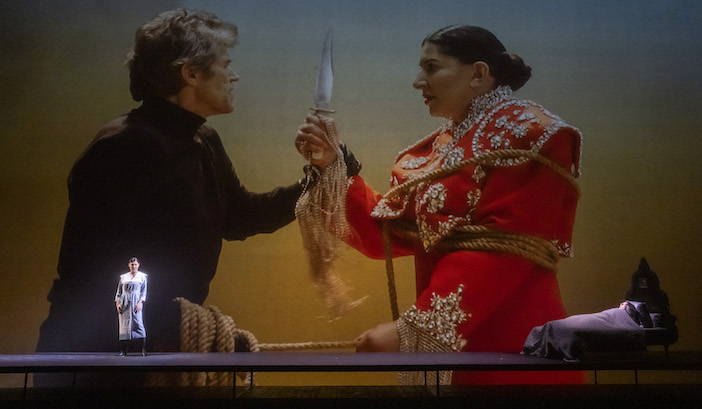
Aigul Akhmetshina (as Carmen), Willem Dafoe and Marina Abramović (as Maria Callas) in ‘7 Deaths Of Maria Callas’ (music by Marko Nikodijević @ London Coliseum). Photo by Tristram Kenton.
Abramović’s show at the RA should be the UK exhibition of the year. From visitors it asks for attention and understanding, of why and how each performance was created, and rewards with a deeper understanding of performance art. Earlier this year, in May, Abramović nearly died from an embolism. She needed nine blood transfusions and came close to death. She says that surviving a near-death experience has made her a happier person. Every day is to be lived.
For someone who has willingly experimented on the edge of death in her work, it will be interesting to see in which direction Abramović’s performance art continues after such a life-changing event.
MARINA ABRAMOVIĆ runs at the Royal Academy until 1 January 2024. For more information, including details of the live performances, please visit www.royalacademy.org.uk.
Header image: detail from The Current (2017), courtesy of the Marina Abramović Archives.

